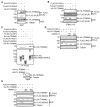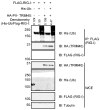Pteropus vampyrus TRIM40 Is an Interferon-Stimulated Gene That Antagonizes RIG-I-like Receptors
- PMID: 38005825
- PMCID: PMC10674255
- DOI: 10.3390/v15112147
Pteropus vampyrus TRIM40 Is an Interferon-Stimulated Gene That Antagonizes RIG-I-like Receptors
Abstract
Nipah virus (NiV; genus: Henipavirus; family: Paramyxoviridae) naturally infects Old World fruit bats (family Pteropodidae) without causing overt disease. Conversely, NiV infection in humans and other mammals can be lethal. Comparing bat antiviral responses with those of humans may illuminate the mechanisms that facilitate bats' tolerance. Tripartite motif proteins (TRIMs), a large family of E3-ubiquitin ligases, fine-tune innate antiviral immune responses, and two human TRIMs interact with Henipavirus proteins. We hypothesize that NiV infection induces the expression of an immunosuppressive TRIM in bat, but not human cells, to promote tolerance. Here, we show that TRIM40 is an interferon-stimulated gene (ISG) in pteropodid but not human cells. Knockdown of bat TRIM40 increases gene expression of IFNβ, ISGs, and pro-inflammatory cytokines following poly(I:C) transfection. In Pteropus vampyrus, but not human cells, NiV induces TRIM40 expression within 16 h after infection, and knockdown of TRIM40 correlates with reduced NiV titers as compared to control cells. Bats may have evolved to express TRIM40 in response to viral infections to control immunopathogenesis.
Keywords: MDA5; Nipah virus (NiV); RIG-I; RIG-I-like receptors; TRIM40; inflammatory responses in bats and humans; innate immunity; tripartite motif (TRIM) proteins; type-I interferons (IFNs).
Conflict of interest statement
The authors declare no conflict of interest.
Figures







Similar articles
-
Transcriptome Profiling of the Virus-Induced Innate Immune Response in Pteropus vampyrus and Its Attenuation by Nipah Virus Interferon Antagonist Functions.J Virol. 2015 Aug;89(15):7550-66. doi: 10.1128/JVI.00302-15. Epub 2015 May 13. J Virol. 2015. PMID: 25972557 Free PMC article.
-
Tetherin Inhibits Nipah Virus but Not Ebola Virus Replication in Fruit Bat Cells.J Virol. 2019 Jan 17;93(3):e01821-18. doi: 10.1128/JVI.01821-18. Print 2019 Feb 1. J Virol. 2019. PMID: 30429347 Free PMC article.
-
The distribution of henipaviruses in Southeast Asia and Australasia: is Wallace's line a barrier to Nipah virus?PLoS One. 2013 Apr 24;8(4):e61316. doi: 10.1371/journal.pone.0061316. Print 2013. PLoS One. 2013. PMID: 23637812 Free PMC article.
-
Lessons from the Nipah virus outbreak in Malaysia.Malays J Pathol. 2007 Dec;29(2):63-7. Malays J Pathol. 2007. PMID: 19108397 Review.
-
Recent Advances and Contradictions in the Study of the Individual Roles of Ubiquitin Ligases That Regulate RIG-I-Like Receptor-Mediated Antiviral Innate Immune Responses.Front Immunol. 2020 Jun 24;11:1296. doi: 10.3389/fimmu.2020.01296. eCollection 2020. Front Immunol. 2020. PMID: 32670286 Free PMC article. Review.
Cited by
-
A Comparative Assessment of the Pathogenic Potential of Newly Discovered Henipaviruses.Pathogens. 2024 Jul 16;13(7):587. doi: 10.3390/pathogens13070587. Pathogens. 2024. PMID: 39057814 Free PMC article. Review.
-
Translational lessons from the balanced immune system in bats.Dis Model Mech. 2025 Sep 1;18(9):dmm050763. doi: 10.1242/dmm.050763. Epub 2025 Feb 19. Dis Model Mech. 2025. PMID: 39968756 Free PMC article. Review.
-
Recent Advances in Immunological Landscape and Immunotherapeutic Agent of Nipah Virus Infection.Cell Biochem Biophys. 2024 Dec;82(4):3053-3069. doi: 10.1007/s12013-024-01424-4. Epub 2024 Jul 25. Cell Biochem Biophys. 2024. PMID: 39052192 Review.
References
-
- Halpin K., Hyatt A.D., Fogarty R., Middleton D., Bingham J., Epstein J.H., Rahman S.A., Hughes T., Smith C., Field H.E., et al. Pteropid bats are confirmed as the reservoir hosts of henipaviruses: A comprehensive experimental study of virus transmission. Am. J. Trop. Med. Hyg. 2011;85:946–951. doi: 10.4269/ajtmh.2011.10-0567. - DOI - PMC - PubMed
-
- Woon A., Boyd V., Todd S., Smith I., Klein R., Woodhouse I., Riddell S., Crameri G., Bingham J., Wang L., et al. Acute experimental infection of bats and ferrets with Hendra virus: Insights into the early host response of the reservoir host and susceptible model species. PLoS Pathog. 2020;16:e1008412. doi: 10.1371/journal.ppat.1008412. - DOI - PMC - PubMed
MeSH terms
Substances
Grants and funding
LinkOut - more resources
Full Text Sources
Research Materials

